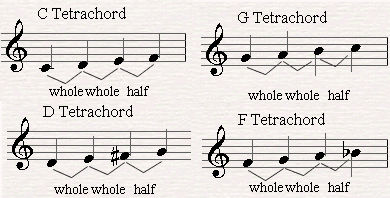
As I was researching and preparing this post, I came across another article about tetrachords for bass players. It was awesome to see and reminded me that music theory transfers across all instruments so easily! I had to copy the title of the article for our blog post today because it’s so true – tetrachords are powerful tools we need to remember to take advantage of!
Students pick up on 5 finger patterns easily. We begin teaching these from their first method book and continue into minor patterns from there. Then comes the jump to playing entire scales. There are all kinds of ways to do this but today I’d like to focus on a fun way to learn tetrachords. Tetrachords are simple – just a series of four notes. Yet when you put two together, they form scales and help us introduce key signatures. Most piano teachers are already aware of the awesomeness of tetrachords, so let’s go onto the fun part!
So today I’m sharing a simple chant I use with my students when teaching tetrachords and preparing for scales. When I taught at Weber State University, several teachers there used it in the group classes so I picked it up. While it is usually taught orally, most of my students prefer to have it written out to practice with at home so I’m sharing my copies here today. Now at first it will be slow going but after a week or two, my students love to put on a fun beat from the keyboard to play along to. It pushes them to name their sharps and prepare their finger faster so it becomes more of a fun game than a technique exercise! Once they’ve learned this chant, we pull out the flashcards for key signatures and move onto single hand fingering for scales. Thanks to the tetrachord introduction, students always understand the concepts of key signatures and scales more easily.
Go ahead and download the pages below so you can try it! When you say it out loud, the rhythm of the chant should fall into place. During the chorus (“Key Note, whole step, whole step, half,…”) the student will play the tetrachord for the key they just named using fingers 5, 4, 3, 2 in both hands with steady quarter notes. If you have any questions, I’ll try to answer them or video one of my students doing this exercise next week!
Download the chant here: Tetrachord Chant – Sharps and Tetrachord Chant – Flats
Author: Whitney
Whitney Hawker, NCTM, teaches group and private piano at Weber State University, Utah. She loves surprising students with the perfect piece or a new exciting game! After graduate school, she missed sharing ideas and resources daily with colleagues so she and her friend, Spring, began blogging together at 4DPianoTeaching.com
